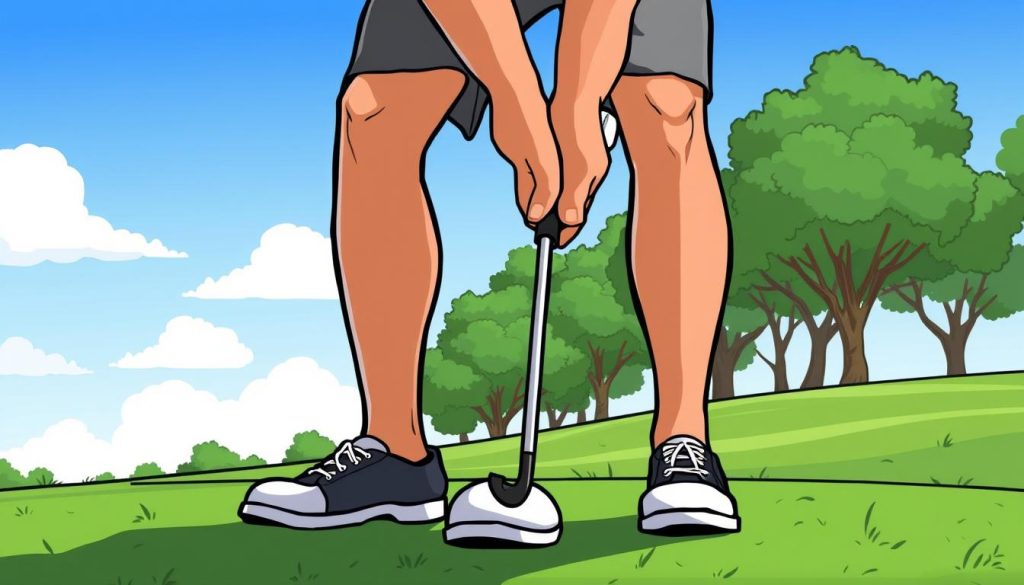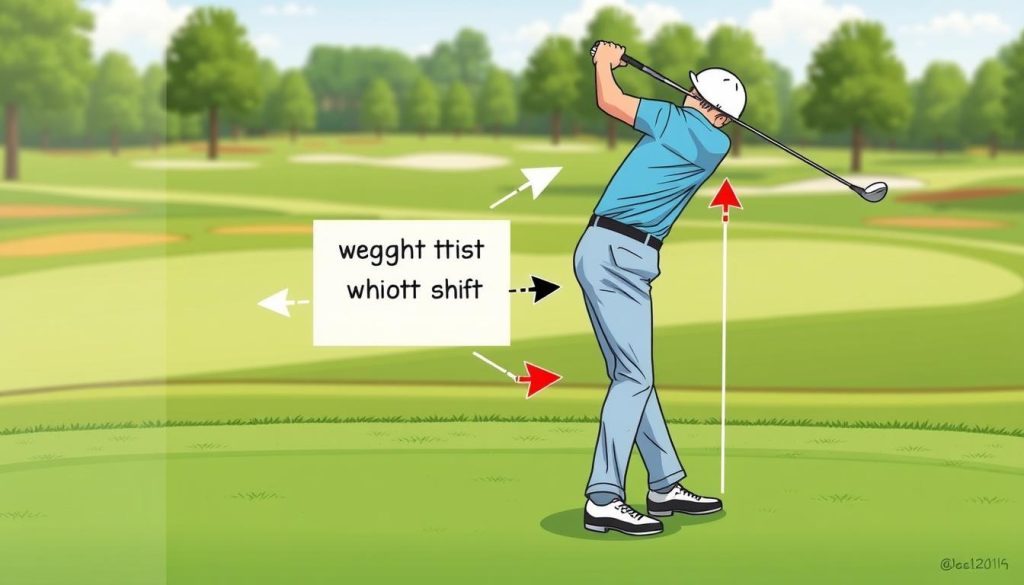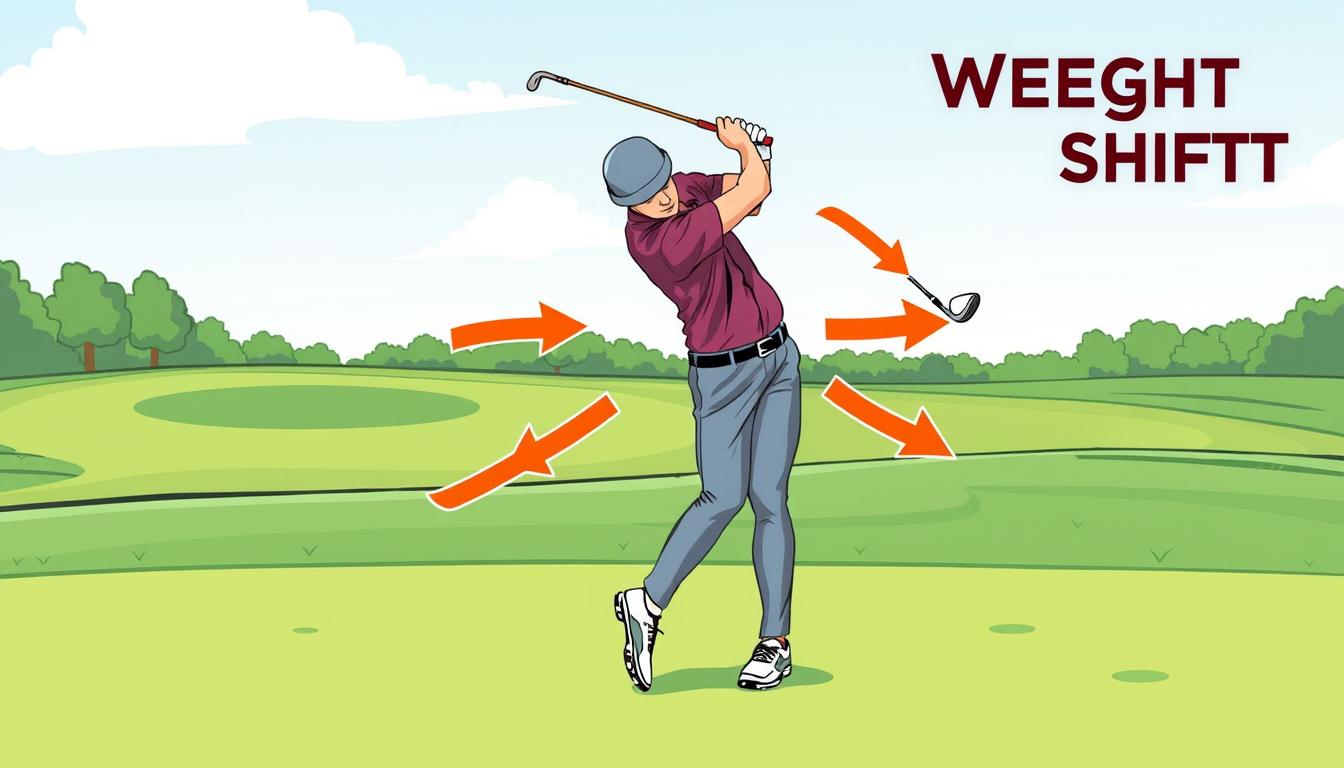Your golf swing mechanics are crucial for your game. Proper weight transfer and pressure shift are vital. This guide will help you grasp the importance of weight distribution in your game.
Golf swing weight shift is not just about moving your body. It’s about managing pressure transfer in your swing. Professional golfers use this to boost power and consistency. By mastering weight transfer, you’ll see better contact, speed, and overall swing.
It’s important to understand the difference between weight and pressure. Weight is your center of mass, while pressure is the force on the ground. The Pressure Plate, a training tool, offers feedback on your pressure shift. It helps you refine your swing without big weight changes.
Key Takeaways
- Proper weight transfer is essential for consistent contact and speed
- Pressure shift differs from weight movement in golf swing mechanics
- Professional golfers shift pressure to the trail leg in backswing
- Most pressure should be on the lead leg before impact
- Even weight distribution or slight lead foot favor at address is recommended
- Slow, controlled practice can permanently change motor patterns
- The Pressure Plate tool can help improve swing technique
Understanding Weight vs Pressure in Golf Swing Mechanics
Golf swing weight shift is key to power and better play. Studies show it can boost power by up to 14%. This means hitting the ball 200 yards could add 30 yards with the right techniques.
Defining Weight Transfer vs Pressure Shift
Weight transfer and pressure shift are different in golf. Weight is where your center of mass is, while pressure is the ground force. You can change pressure without moving much, like a sprinter at the start.
The Science Behind Center of Mass
Your center of mass is crucial for balance in the swing. Most pros have 75-80% of their weight on the right side at the top. This helps power the downswing.
Ground Force Reaction in Golf
Ground force reaction is key for power and stability. Proper pressure transfer lets you use the ground better. The Pressure Plate helps golfers connect foot pressure to the ground.
| Pressure Distribution | Plate Tilt |
|---|---|
| 60%+ on trail side | Backward |
| 70%+ on lead side | Forward |
Grasping these concepts can greatly enhance your golf swing and performance.
Proper Setup Position for Optimal Weight Distribution
A good golf setup is key to a strong and accurate swing. Getting the right balance and weight at address can really boost your game. Let’s look at the important parts of a proper setup and how they help your game.
Balanced Address Position
Start with your feet shoulder-width apart for a balanced address. Your weight should be evenly spread, with a bit more on the balls of your feet. This balance helps you stay stable and move smoothly during your swing.
Club-Specific Weight Distribution
Each club needs a slightly different setup. For irons, keep your weight evenly split. With a driver, lean a bit more on your trail foot, about 55-45. This helps you hit the ball farther.
| Club Type | Weight Distribution (Lead:Trail) |
|---|---|
| Driver | 45:55 to 50:50 |
| Irons | 55:45 |
| Wedges | 55:45 |
Athletic Stance Fundamentals
An athletic stance is vital for a dynamic swing. Slightly bend your knees and lean forward from the hips. This stance helps you transfer weight and stay balanced. Keep your spine straight and chin up for a full shoulder turn.
Remember, a good golf setup with the right weight distribution is essential for a strong swing. Practice these basics to get better and play your best on the course.
Golf Swing Weight Shift Guide: Step-by-Step Process
Improving your golf game starts with mastering the swing sequence. This guide will help you improve your weight shift and swing mechanics. A proper swing sequence relies on maintaining balance and generating power through a fluid motion. To achieve this, focus on your posture and ensure a strong foundation with the correct stance. Additionally, incorporating golf swing grip tips can help you hold the club in a way that maximizes control and consistency throughout your swing.
Begin with a balanced setup. Your weight should be evenly split between both feet. For right-handed golfers, this means 50% on each foot at the start.
As you start your backswing, move some weight to your trail side. Shift weight onto your right instep in the first 12 inches. Aim for 60-70% of your weight on your right foot at the backswing’s top.
Keep your spine angle the same during the backswing. This keeps your posture right and makes the downswing smoother.
Start the downswing by moving weight to your lead side. This is where power is built. Your hips should move first, followed by your shoulders.
At impact, your weight should be mostly on your left foot. This helps hit the ball solidly.
Finish your swing with weight still on your left foot. By the end, most of your weight should be there, with a bit on the right.
- 50% of golfers prefer an athletic position for optimal swing posture
- 85% of golfers build speed progressively in the downswing
- Consistency in weight transfer is key for solid ball striking
Practice regularly and use video analysis to improve. Professional coaching can also give you personalized tips to better your swing.
The Backswing Weight Transfer Technique
Mastering the backswing is key for a strong and accurate golf swing. Proper weight transfer is essential for a successful shot.
Loading the Trail Side
Focus on loading the trail side during your backswing. Shift about 60% of your weight to your back foot. This stored energy helps you hit the ball powerfully.
Maintaining Spine Angle
Keep your spine angle steady as you load your trail side. This alignment ensures a stable swing. A consistent spine angle helps you hit more accurately and reduces injury risk.
Common Backswing Weight Shift Errors
Many golfers make mistakes with weight transfer in their backswing. Swaying instead of turning is a common error. It can cause inconsistent ball contact. Not enough weight on the trail side also reduces downswing power.
| Weight Distribution | Proper Technique | Common Error |
|---|---|---|
| Start of Backswing | 50/50 | 60/40 (front-heavy) |
| Top of Backswing | 60/40 (back-heavy) | 50/50 or 40/60 (front-heavy) |
| Impact | 70/30 (front-heavy) | 50/50 or 60/40 (back-heavy) |
By focusing on proper trail side loading, maintaining your spine angle, and avoiding common weight shift errors, you’ll improve your backswing technique. This will help you hit more consistent and powerful shots.
Mastering the Downswing Weight Transfer
The downswing weight shift is key for power and accuracy in your golf swing. Start by putting more pressure on your lead side. Try to have at least 70% of your weight on your lead foot before your hands reach waist height. This move starts the downswing sequence.
Then, focus on hip rotation. Move your hips and left knee slightly toward the target. This should be about two inches. Make this move before bringing the club down. It helps avoid common issues like getting stuck or spinning out with your hips.
Professional golfers show how important this technique is. Greg, an Irish pro, shifts his weight laterally in his downswing, almost as much as his pelvis width. Tiger Woods also moves his hips laterally, but without sliding.
Woods’ signature move is a squat. This move uses the ground for stability, engaging his hip stabilizers and glutes. It keeps his hips stable for impact. Slowing down hip rotation through squatting helps sequence movements and improves stability at impact.
| Swing Phase | Weight Distribution |
|---|---|
| Address | 50% on each foot |
| Top of Backswing | 75% on back foot |
| Impact | 75% on front foot |
| Finish | 90%+ on front foot |
To get better at downswing weight shift, try the Medicine Ball throw drill. This drill helps with weight transfer and can boost your throwing distance. This means more power in your golf swing.
Impact Position and Weight Distribution
The impact position is key for a strong and accurate golf shot. Your body alignment and weight distribution are crucial. They help transfer energy to the ball.
Lead Side Dominance
At impact, you should feel pressure on your lead side. This means about 90% of your weight is on your front foot. This forward weight shift helps you compress the ball and control its flight path.
Ground Force Utilization
To maximize power, use ground force effectively. Push into the ground with your legs as you swing down. This action straightens both legs, creating a powerful upward force that adds speed to your club.
Hip Position at Impact
Your hip rotation is vital for a solid impact. The right hip should move to where the left hip was at the top of your backswing. This lateral shift indicates proper weight transfer and helps you hit the ball squarely.
| Aspect | Ideal Distribution | Purpose |
|---|---|---|
| Weight at Impact | 90% on Front Foot | Ball Compression |
| Ground Force | Both Legs Pushing | Power Generation |
| Hip Position | Right Hip Forward | Energy Transfer |

Remember, mastering the impact position takes practice. Focus on lead side pressure, ground force utilization, and proper hip rotation. These elements combined will help you achieve solid ball contact and improve your overall golf game.
Follow-Through Weight Distribution Patterns
The golf follow-through is key for a balanced swing. Your weight flow after hitting the ball shapes your finish and balance. Let’s look at how to improve your follow-through for better shots.
Post-Impact Weight Flow
When you hit the ball, your weight should move to your lead side. This move helps power and accuracy. Pro golfers move their weight about their pelvis width during this phase.
Finish Position Mechanics
A solid finish shows you’ve done the weight transfer right. Your back foot should be on its toes lightly. Most of your weight is on the front leg, making a stable pose.
Studies show skilled golfers shift 80% of their weight to the back foot in the backswing. Then, they move it forward, reaching up to 142% of their body weight on the front foot at impact. This quick transfer boosts power, adding 30 yards to your drive.
- Keep your spine angle steady throughout the swing
- Allow your hips to rotate fully towards the target
- Balance on your lead foot in the finish, with your back foot lightly touching for support
Practice these follow-through patterns to better your golf swing. Remember, a good finish often means a good shot. So, focus on ending in a balanced, confident pose.
Common Weight Shift Mistakes and Corrections
Golf swing faults often come from wrong weight placement. Let’s look at common mistakes and how to fix them to boost your game.
Reverse Pivot Prevention
A reverse pivot happens when your weight moves to the front foot in the backswing. This takes away power and accuracy. To avoid it, focus on turning your upper body while keeping your weight balanced over your feet. Practice feeling pressure on the inside of your back foot at the backswing’s top.
Early Weight Shift Solutions
An early weight shift can cause shots to top or thin out. To fix this, keep your spine angle steady throughout the swing. Start your downswing with a slight shift towards the target before rotating your hips. This helps you stay behind the ball for better contact.

Swaying vs Turning
Swaying instead of turning is a common fault. It leads to inconsistent contact and lost power. To correct this, think of your spine as an axis. Turn around this axis, not slide sideways. A good drill is to practice swings with your back against a wall, ensuring solid contact throughout.
Remember, proper weight transfer is key for power and solid contact. At impact, aim for about 80% of your weight on your lead foot. By fixing these common weight shift issues, you’ll hit more consistent and powerful golf shots.
Conclusion
Mastering weight shift techniques is key for better golf swings. Understanding how to distribute weight and shift pressure can greatly improve your ball-striking. To improve, focus on setting up right, transferring weight correctly, and mastering swing mechanics.
The most common swing flaw is a slice. To fix it, focus on rotation. Simplify your swing thoughts and imagine the right hand path for better shots. Tools like the “Lag Shot” can help you see what needs work.
Trying different swing weights can also help. Adding 2g of weight can change your swing by +/- 1 point. This lets you fine-tune your swing. With practice and the right guidance, you’ll see big improvements in your game.
FAQ
What’s the difference between weight and pressure in the golf swing?
How should I distribute my weight at address for iron shots?
What’s the proper weight distribution for driver setup?
How much pressure should be on my trail foot during the backswing?
When should I start shifting pressure to my lead side in the downswing?
What should my weight distribution be like at impact?
How can I tell if I’m performing a reverse pivot?
What are some drills to improve my weight shift?
How does ground force reaction affect my golf swing?
What should my finish position look like in terms of weight distribution?
Source Links
- https://whygolf.com/blogs/whysguyscorner/weight-shift-in-golf-swing?srsltid=AfmBOoqSgwcq8XPZVJzII9e_5IaRq5-K0l4-UxtYWJ44P8iYT6Y9LlKh
- https://www.pxg.com/the-range/blog/swing-weight-guide/?srsltid=AfmBOoozdO4Mnm7jzpmHEIG1gxxA11dGlsFyo9-rvLEKl3ze9BMOvw64
- https://rotaryswing.com/golf-instruction/golfbiomechanics/weight-shift
- https://whygolf.com/blogs/whysguyscorner/weight-shift-in-golf-swing?srsltid=AfmBOooNeUB2WmoIBo1Pz9CbN3shqhLmTEIK6xo51_99x6tYedMrmqxf
- https://whygolf.com/blogs/whysguyscorner/weight-shift-in-golf-swing?srsltid=AfmBOoryWCLhgyBvvdjF7RhzozCc5X4rWMsdidqmEz80pi-Z_7BjMa8e
- https://www.golfmonthly.com/videos/golf-swing-tips/weight-distribution-in-the-golf-swing
- https://forums.golfmonthly.com/threads/where-should-my-weight-be-during-my-setup-then-through-the-swing.93081/
- https://lilyfieldphysio.com.au/blog/uncategorized/mastering-golf-swing-step-by-step-guide/
- https://englandigolf.co.uk/igolf-blog/how-to-swing-a-golf-club-a-step-by-step-guide/
- https://golf-info-guide.com/golf-tips/the-golf-swing/golf-swing-tip-weight-transfer-from-start-to-finish/
- https://whygolf.com/blogs/whysguyscorner/weight-shift-in-golf-swing?srsltid=AfmBOoogUAE1ykFNP9QkpU1yC4Nvuqsx20X7WfjKXC6MpUDfRDcpNgpy
- https://rotaryswing.com/c4/112208-intro-to-weight-shift-in-the-golf-swing
- https://rotaryswing.com/golf-instruction/golfbiomechanics/weight-shift-golf-swing
- https://theleftrough.com/weight-transfer-golf/
- https://www.swingtuneup.com/post/weight-distribution-and-impact
- https://collegeofgolf.keiseruniversity.edu/weight-shift-varies-with-club-length/
- https://www.ncbi.nlm.nih.gov/pmc/articles/PMC3737954/
- https://golf-info-guide.com/video-golf-tips/golf-weight-shift-doing-it-the-right-way-video/
- https://hackmotion.com/common-golf-swing-mistakes/
- https://cattailcrossing.ca/blog/fixing-common-problems-with-your-golf-swing/
- https://skillest.com/blog/a-comprehensive-guide-to-mastering-the-golf-swing/
- https://swingfit.net/golf-swing-mechanics/
- https://shaftconnect.com/blogs/swing-weight/golf-weight-buying-guide?srsltid=AfmBOorhS8Xe735Fn4AgQMFzWriRhAlu1dj_Mrv1svZKyJU2ABcFShHZ


